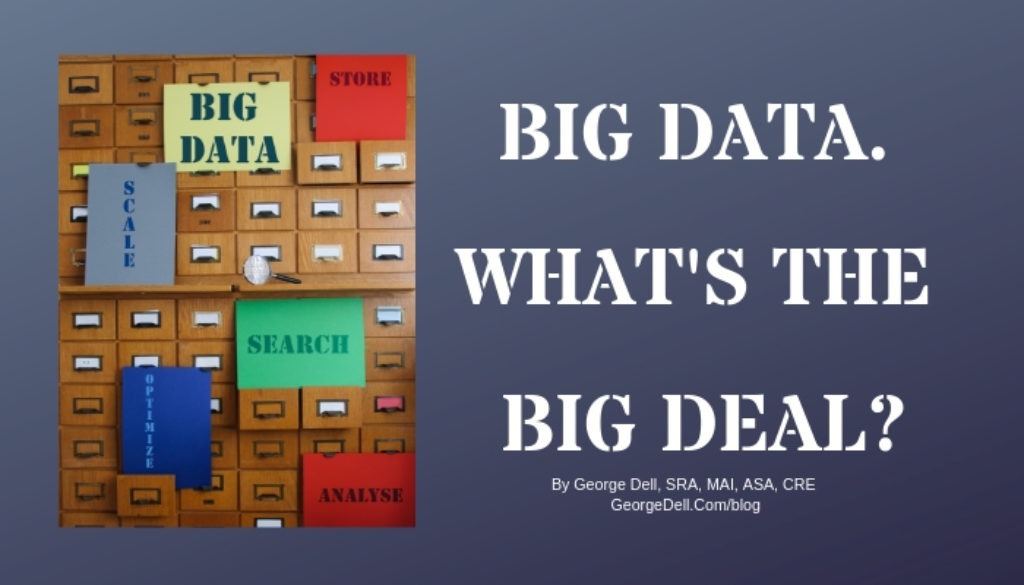Big data is in the news.
Why is big data a big deal? What does big data mean to appraisers? And what of those who care about collateral risk, litigation damages, investment risk and portfolio risk.
Perhaps we are progressing out of the age of information to the “age of connection.” Yes, we are connected by social media, cell phones, wearables, and The Internet of Things (email from your fridge that you need to buy milk). It’s the age of machine-learning algorithms. Soon, we’ll tell the car where to go. It will take us there better and safer than if we are driving.
Big data is everything connected to today’s huge data sets – in different places, in different forms, intentionally and unintentionally collected, often with no purpose in mind. It’s data waiting for someone to find a problem to solve. We used to scratch together information to solve a problem. Today we have masses of data, waiting for a problem to be asked.
Simply put, big data has to do with the huge, growing amount of electronic information available to you. Data science focuses on the management of data, its analysis, and conveying results, decisions and recommendations. Data science includes statistics, computation, and human interface to the machine.
The valuation process has come to the same place.
It has undergone an evolution. This evolution has been controlled by what data came to be available:
- To the 1970s,: the data rummage era, based on scarce availability, using whatever we could find;
- To the 1980s: the market analysis era, based on convenience, using ‘similar’ sales;
- To the turn of the new century: the data discarding era, based on avoidance, deleting all but three or six sales;
- Today: the data optimization era, based on the complete competitive market segment.
The data rummage and optimization eras optimized analyst/appraiser usefulness. The middle two do not.
In the market analysis era, we evolved to defining and focusing on markets, but still used convenient information. In the data discarding era, we happily took advantage of easy data, but ignored the possibility of more reliable and more credible results from using and analyzing all information. We turned a blind eye, not seeing, and not hearing the words:
“An appraiser must collect, verify, and analyze all information necessary for credible assignment results.” (USPAP SR1-4)
Is subjective ‘credible’ enough? Or can we measure and maximize objective reliability?
Data science, EBV (Evidence Based Valuation)© gives us higher objective reliability, and thus a far higher professional subjective reliability of our work. Should our goal be maximal reliability, or is subjective ‘believability’ enough?
Stay tuned. Same time. Same channel. We will explore this more.

March 15, 2017 @ 7:57 pm
Big Data is a tool, just the same as anything else that is put to work in the performance of a task. As with any other tool the user must be schooled and trained in the proper use of a tool. A powered circular saw is able to cut of fingers just as easily as it is able to cut off the end of a board. The same sort of disasters can result when Big Data is misapplied.
The biggest benefit that I have seen thus far is the CRMLS.org mapping feature that can be displayed instead of the results of the search. With the mapping I get the view from 5,000 feet up of the market. I am sufficiently familiar with the Inland Empire and San Gabriel Valley areas that knowing where my subject property is located I can immediately measure the market activity in the Subject’s neighborhood and select the properties that are the most proximate and similar.
I am very aware of, and grateful for, all of the work that takes place behind the scenes to make this convenience possible, Once I have my six and twelve month quick CMAs loaded up and my Gandysoft.com market regression report completed, I am off to complete an appraisal that will make the reviewer happy that he or she does not need to ask for any corrections or clarifications as it is all there for them. That is good for me as armed with additional understanding I am off to the next assignment.
March 20, 2017 @ 7:04 pm
Our goal should be to maximize our reliability. If we don’t, it won’t be long before appraisers are obsolete and all you need are people to help collect data.
April 21, 2017 @ 4:36 pm
Interesting. True that big data misused can be a problem. In fact, it may be that access to complete data makes it easier to the less-than-ethical practitioners to “fudge” the value. My experience in working on fraud-type cases, and in review work — is that adjustments are not really suitable for fudging value conclusions. Comp selection is.
The profession needs (in my opinion) to provide us with the education on how to handle today’s technology. This is primarily the existence of complete data sets, and the analytical software available today (computation). We need new thinking, new skills, and new protocols.
In these ways, reliability is measurably maximized.
The opportunity for the profession is tremendous (in my opinion). We need our professional organizations to answer the call.